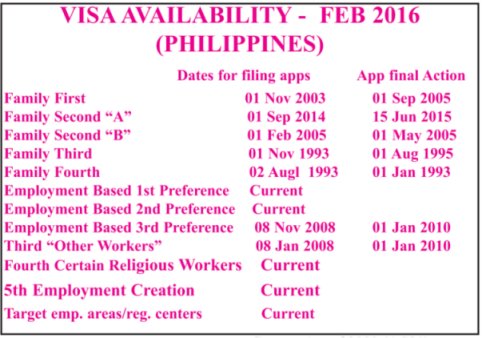By: Robert Gard
Department of Homeland Security (DHS) Issues Long Awaited Proposed Regulations: “Retention of EB-1, EB-2, and EB-3 Immigrant Workers and Program Improvements Affecting High-Skilled Nonimmigrant Workers” Rules for “I-140 Employment Authorization Document” (EAD)
 On December 31, 2015, the Department of Homeland Security (DHS) published (in the Federal Register) long awaited proposed regulations, thus starting a 60-day comment period before those regulations may go into effect. The Department of Homeland Security (DHS) is proposing to amend its regulations related to certain employment-based immigrant and nonimmigrant visa programs. The proposed amendments would provide various benefits to participants in those programs, including: improved processes for U.S. employers seeking to sponsor and retain immigrant and nonimmigrant workers, greater stability and job flexibility for such workers, and increased transparency and consistency in the application of agency policy related to affected classifications.
On December 31, 2015, the Department of Homeland Security (DHS) published (in the Federal Register) long awaited proposed regulations, thus starting a 60-day comment period before those regulations may go into effect. The Department of Homeland Security (DHS) is proposing to amend its regulations related to certain employment-based immigrant and nonimmigrant visa programs. The proposed amendments would provide various benefits to participants in those programs, including: improved processes for U.S. employers seeking to sponsor and retain immigrant and nonimmigrant workers, greater stability and job flexibility for such workers, and increased transparency and consistency in the application of agency policy related to affected classifications.
Many of these changes are primarily aimed at improving the ability of U.S. employers to hire and retain high-skilled workers who are beneficiaries of approved employment- based immigrant visa petitions and are waiting to become lawful permanent residents (LPRs), while increasing the ability of such workers to seek promotions, accept lateral positions with current employers, change employers, or pursue other employment options.
First, DHS proposes to amend its regulations consistent with certain worker portability and other provisions in the American Competitiveness in the Twenty-first Century Act of 2000 (AC21), as amended, as well as the American Competitiveness and Workforce Improvement Act of 1998 (ACWIA). These proposed amendments would clarify and improve longstanding agency policies and procedures—previously articulated in agency memoranda and precedent decisions—implementing sections of AC21 and ACWIA related to certain foreign workers, including sections specific to workers who have been sponsored for LPR status by their employers. In so doing, the proposed rule would enhance consistency among agency adjudicators and provide a primary repository of governing rules for the regulated community. In addition, the proposed rule would clarify several interpretive questions raised by AC21 and ACWIA.
Second, consistent with existing DHS authorities and the goals of AC21 and ACWIA, DHS proposes to amend its regulations governing certain employment-based immigrant and nonimmigrant visa programs to provide additional stability and flexibility to employers and workers in those programs.
The proposed rule would, among other things: improve job portability for certain beneficiaries of approved employment-based immigrant visa petitions by limiting the grounds for automatic revocation of petition approval; further enhance job portability for such beneficiaries by increasing their ability to retain their priority dates for use with subsequently approved employmentbased immigrant visa petitions; establish or extend grace periods for certain high-skilled nonimmigrant workers so that they may more easily maintain their nonimmigrant status when changing employment opportunities; and provide additional stability and flexibility to certain high-skilled workers by allowing those who are working in the United States in certain nonimmigrant statuses, are the beneficiaries of approved employment-based immigrant visa petitions, are subject to immigrant visa backlogs, and demonstrate compelling circumstances to independently apply for employment authorization for a limited period. These and other proposed changes would provide much needed flexibility to the beneficiaries of employment-based immigrant visa petitions, as well as the U.S. employers who employ and sponsor them for permanent residence.
Finally, to provide additional certainty and stability to certain employment authorized individuals and their U.S. employers, DHS is also proposing changes to its regulations governing the processing of applications for employment authorization to minimize the risk of any gaps in such authorization. These changes would provide for the automatic extension of the validity of certain Employment Authorization Documents (EADs or Forms I-766) for an interim period upon the timely filing of an application to renew such documents. At the same time, in light of national security and fraud concerns, DHS is proposing to remove regulations that provide a 90-day processing timeline for EAD applications and that require the issuance of interim EADs if processing extends beyond the 90-day mark.
Executive Summary Section Retention of employment-based immigrant visa petitions – For EB-1, EB-2 and EB-3 applicants with petitions pending 180 days or more, no automatic revocation based solely on withdrawal by the petitioner or termination of petitioner’s business. Not applicable in cases of fraud, material misrepresentation, revocation or invalidation of a labor certification or USCIS error. Beneficiary would still need a new job offer and “may need another immigrant visa petitioner”
Priority Date Retention – Priority date retention will be available so long as the initial immigrant visa petition was approved and the approval has not been revoked for fraud, material misrepresentation, invalidation of a labor certification or USCIS error.
Non immigrant grace periods – There will be a new one-time grace period, during an authorized validity period, of up to 60 days whenever employment ends for E-1, E-2, E-3, H-1B, H-1B1, L-1, or TN non immigrants. No working during the grace period. Also, DHS “in its discretion may eliminate or shorten the 60-day grace period on a case-by-case basis.”
Eligibility for employment authorization in compelling circumstances – DHS proposes to allow E- 3, H-1B, H-1B1, L-1, or O-1 NIVs to apply for separate employment authorization for a limited period if there are compelling circumstances that, in the discretionary determination of DHS, justify the consideration of such employment authorization.
H-1B licensing – For occupations requiring a license, H-1B application requirements satisfied if a license application is filed, but not obtained because a state or locality requires a social security number of the issuance of employment authorization before accepting or approving much requests. Also deemed satisfied if the unlicensed worker will be working in a state that allows such individuals to work under the supervision of a licensed senior or supervisory personnel.
EAD extensions – Automatic 180 day extension of employment authorization so long as 1) a renewal I-765 application is filed based same category as previously issued EAD (except if it’s a TPS recipient); 2) the renewal is filed before the current EAD has expired; and 3) the person’s eligibility for employment authorization continues beyond the expiration of the EAD and an independent adjudication of the individual’s underlying eligibility is not a prerequisite to the extension of the EAD (note: assuming this would be in situations where an underlying I- 130 or I-140 have not been approved yet). The long-standing 90 day time limit regulation for adjudicating EADs would be eliminated.
The State of Illinois May Have Run Out Of Time in Bringing State Issued Identification Documents Into Compliance With the “Real ID Act” Passed by Congress in 2005 Secure driver’s licenses and identification documents are a vital component of our national security framework. The REAL ID Act, passed by Congress in 2005, enacted the 9/11 Commission’s recommendation that the Federal Government “set standards for the issuance of sources of identification, such as driver’s licenses.” The Act established minimum security standards for license issuance and production and prohibits Federal agencies from accepting for certain purposes driver’s licenses and identification cards from states not meeting the Act’s minimum standards. The purposes covered by the Act are: accessing Federal facilities, entering nuclear power plants, and, no sooner than 2016, boarding federally regulated commercial aircraft for both domestic and international travel. Many states and other jurisdictions have made significant progress in enhancing the security of their licenses over the last number of years. As a result, approximately 70- 80% of all U.S. drivers hold licenses from jurisdictions: (1) determined to meet the Act’s standards; or (2) that have received extensions to allow more time to comply with the enhanced security standards. Individuals holding driver’s licenses or identification cards from these jurisdiction may continue to use them as before. The State of Illinois has requested a further extension of their temporary exemption, stating that full compliance would cost the essentially bankrupt State at least $4 Million, but the Federal Government has refused to grant this latest extension request, so “Phase IV” enforcement of the Real ID Act for those presenting Illinois ID or driver’s licenses may begin as early as January 10, 2016.
Phase 4: Boarding federally regulated commercial aircraft. A driver’s license or identification card from a noncompliant state may only be used in conjunction with an acceptable second form of ID for boarding federally regulated commercial aircraft (such as a valid passport.)
Some states have bitterly opposed these requirements out of privacy concerns, and more than a dozen have passed laws barring their motor vehicle departments from complying with the law, according to the National Conference of State Legislatures. The new standards require more stringent proof of identity and will eventually allow users’ information to be shared more easily in a national database. Privacy experts, civil liberty organizations and libertarian groups fear the law would create something like a national identification card. The federal government cannot force states to adopt these identification standards, but it can gain compliance in other ways. In October, it began requiring that visitors to military bases, nuclear plants and federal facilities produce a driver’s license from a state that complies with the law, or show another form of government ID, like a passport. The DHS said it would provide a schedule by the end of this year for when airport screeners would start accepting only driver’s licenses that complied with federal standards. It said that 120 days’ notice would be given before starting to enforce the law at airports. Passengers who do not have a compliant type of identification will have to produce another type of government-approved identification.
COPYRIGHT BY AUTHOR — 2016
This article is designed to provide accurate and authoritative information in regard to the subject matter covered. It is published and distributed with the understanding that the publisher is not engaged in rendering legal, accounting or other professional service. It is submitted for publication by the author with the understanding that each individual case is different, and this article is not a formal legal opinion and should not be relied upon as advice by the author in a particular legal situation.
 VIA Times – January 2016 Issue Vital News, Vibrant VIews for Asian Americans in Chicago & Midwest
VIA Times – January 2016 Issue Vital News, Vibrant VIews for Asian Americans in Chicago & Midwest


